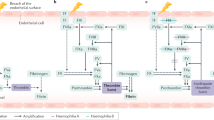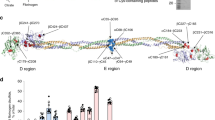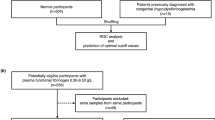Abstract
THE primary physiological function of fibrinogen is fibrin clot formation, a process that requires three distinct reactions. Thrombin first cleaves fibrinopeptides A and B from two of the three pairs of polypeptide chains (Aα, Bβ, γ) of fibrinogen1, following which the remaining fibrin monomers polymerise spontaneously into an insoluble fibrin clot2. Thrombin also converts Factor XIII to an active form, called plasma transglutaminase3, which in turn catalyses the formation of covalentγ-glutamyl-ε-lysine isopeptide bonds4 between two γ chains and more than two α chains of different fibrin molecules5. The resultant γ chain dimers and α chain polymers crosslink the fibrin network and render it resistant to chemical or physical modifications.
This is a preview of subscription content, access via your institution
Access options
Subscribe to this journal
Receive 51 print issues and online access
$199.00 per year
only $3.90 per issue
Buy this article
- Purchase on Springer Link
- Instant access to full article PDF
Prices may be subject to local taxes which are calculated during checkout
Similar content being viewed by others
References
Blombäck, B., and Johnson, A. J., Thromb. Diath. Haemorrh., 51, 251–256 (1971).
Doolittle, R. F., Adv. Prot. Chem., 27, 1–109 (1973).
Loewy, A. G., in Fibrinogen (edit. by Laki, K.), 185–223 (Marcel Dekker, Inc., New York, 1968).
Pisano, J. J., Finlayson, J. S., and Peyton, M. P., Science, 160, 892–893 (1968).
McKee, P. A., Mattock, P., and Hill, R. L., Proc. natn. Acad. Sci. U.S.A., 66, 738–744 (1970).
Ménaché, D., Thromb. Diath. Haemorrh., 29, 525–535 (1973).
Ratnoff, O. D., Progress in Hemostasis and Thrombosis (edit. by Spaet, T. H.), 1, 39–74 (Grune and Stratton, New York, 1972).
Blombäck, M., Blombäck, B., Mammen, E. F., and Prasad, A. S., Nature, 218, 134–137 (1968).
Ménaché, D., Proc. ninth Congr. Eur. Soc. Haematol., Lisbon, 1255–1259 (S. Karger, Basel and New York, 1963).
Guillin, M.-C., and Ménaché, D., Thromb. Res., 3, 117–135 (1973).
Blombäck, B., and Blombäck, M., Nouv. Rev. Fr. Hématol., 10 671–678 (1970).
Blombä;ck, B., and Blombäck, M., Arkiv. Kemi., 10, 415–443; (1956).
Loewy, A. G., Dunathan, K., Kriel, R., and Wolfinger, H. L., jun., J. biol. Chem., 236, 2625–2633 (1961).
Weber, K., and Osborn, M., J. biol Chem., 244, 4406–4412 (1969).
Budzynski, A. Z., Marder, V. J., and Shainoff, J. R., J. biol. Chem., 249, 2294–2302 (1974).
Chen, R., and Doolittle, R. F., Biochemistry, 10, 4486–4491 (1971).
Author information
Authors and Affiliations
Rights and permissions
About this article
Cite this article
BUDZYNSKI, A., MARDER, V., MÉNACHÉ, D. et al. Defect in the gamma polypeptide chain of a congenital abnormal fibrinogen (Paris I). Nature 252, 66–68 (1974). https://doi.org/10.1038/252066a0
Received:
Revised:
Issue Date:
DOI: https://doi.org/10.1038/252066a0
This article is cited by
-
Congenital dysfibrinogenemias. A review
La Ricerca in Clinica e in Laboratorio (1985)
-
Fibrinogen γ chain locus is on chromosome 4 in man
Human Genetics (1982)
-
Dysfibrinogen�mie
Klinische Wochenschrift (1977)
Comments
By submitting a comment you agree to abide by our Terms and Community Guidelines. If you find something abusive or that does not comply with our terms or guidelines please flag it as inappropriate.



